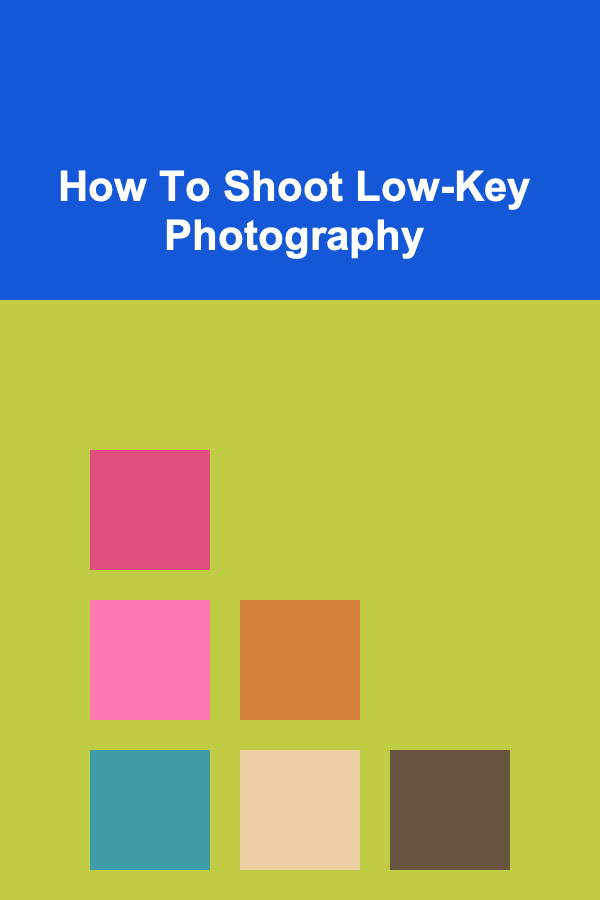
How To Shoot Low-Key Photography
ebook include PDF & Audio bundle (Micro Guide)
$12.99$7.99
Limited Time Offer! Order within the next:

Low-key photography is a striking style that emphasizes shadows and contrasts to create dramatic, moody, and intense images. Unlike traditional high-key photography, where the lighting is soft and bright, low-key photography thrives on shadows, underexposed elements, and a controlled interplay of light and darkness. This technique can be used to evoke emotion, draw attention to specific details, and even convey a sense of mystery or tension.
In this comprehensive guide, we will explore the essentials of low-key photography, including the equipment you'll need, tips for lighting setups, and techniques to help you master this powerful style. Whether you're a beginner or an experienced photographer looking to experiment with something new, this article will provide all the information you need to start shooting breathtaking low-key photos.
What is Low-Key Photography?
Low-key photography involves using predominantly dark tones in your image, where most of the scene is in shadow. The contrast between light and dark is exaggerated, and the lighting is often stark, focusing on specific elements while leaving others obscured in darkness. This style of photography can convey a range of emotions, from somber to mysterious, and is frequently used in portrait, product, and fine art photography.
In a typical low-key image, only a small part of the subject is illuminated, and the light is usually hard and directed, producing strong shadows. This creates a high contrast between the lit areas and the surrounding darkness, resulting in a sense of drama. The reduced use of light allows the photographer to guide the viewer's eye to the subject while also leaving much to the imagination.
Key Characteristics of Low-Key Photography:
- Dark tones dominate: The background and surrounding areas are often dark or completely black.
- High contrast: There's a strong difference between the light and dark areas, often resulting in bold and dramatic shadows.
- Minimal light: The lighting setup typically involves very little light, usually focused on a small area of the subject.
- Mood and emotion: Low-key photography is often associated with moodiness, intensity, and emotion.
Equipment You'll Need for Low-Key Photography
While you don't need specialized equipment to create low-key photos, there are a few key tools that will help you achieve better results. Below are the essential pieces of equipment you'll need for low-key photography.
1. Camera
A digital camera with manual controls is essential for low-key photography. You'll need to have control over the exposure settings, especially the aperture, shutter speed, and ISO, to properly adjust the amount of light entering the camera.
- DSLRs and mirrorless cameras: Both types of cameras are perfect for low-key photography. They offer manual mode, where you can adjust settings to control exposure.
- Lenses: A fast lens with a wide aperture (f/2.8 or lower) will help you control the depth of field and allow more light to hit the sensor.
2. Lighting Equipment
While you can create low-key effects using natural light, studio lighting gives you much more control over the outcome.
- Strobe lights: These are powerful lights that can be adjusted to produce the specific amount of light needed for low-key photography. A single strobe or a softbox can create the dramatic shadows typical of low-key images.
- Continuous lights: These are another option, providing a constant light source that can be adjusted easily. LED panels or other constant light sources can be used for this type of photography.
- Modifiers: Light modifiers such as softboxes, grids, or snoots help control the spread and direction of light. These modifiers allow you to focus the light precisely on the subject while leaving the surrounding areas dark.
3. Light Stands and Mounts
For precise lighting setups, you'll need a way to mount your light sources. Light stands are essential for positioning your strobes, softboxes, or continuous lights at different angles and distances.
4. Reflectors and Flags
Reflectors can bounce light back onto your subject to fill in shadows, while flags are used to block light and deepen shadows in certain areas. Both are essential tools for fine-tuning your low-key lighting setup.
5. Background
While you can use any background for low-key photography, darker backgrounds work best to enhance the low-key effect. A black backdrop is ideal because it absorbs light and prevents any unwanted reflections.
Lighting Techniques for Low-Key Photography
Lighting is arguably the most critical aspect of low-key photography. The way you position your lights, the type of light you use, and how you manipulate shadows will dictate the mood of the final image.
1. Single Light Source
One of the simplest ways to achieve low-key photography is by using a single light source. This light can be placed at various angles to create different moods.
- Side lighting: Placing the light to the side of the subject creates deep shadows on one side of the face or body, which adds drama and contrast.
- Rembrandt lighting: This is a classic lighting technique where the light is positioned at a 45-degree angle to the subject, creating a triangle of light on the cheek opposite the light source.
- Butterfly lighting: In this setup, the light is placed directly in front and above the subject, casting shadows that form a butterfly shape under the nose. This lighting produces soft, but dramatic shadows.
2. High Contrast Lighting
The key to low-key photography is creating strong contrasts between the light and dark areas of your image. This is achieved by using hard light and positioning the light source close to the subject.
- Hard light: Hard light is produced using a small light source or a light source that is focused on a specific area. This type of lighting creates sharp, defined shadows.
- Chiaroscuro: This technique, borrowed from fine art painting, is about the use of strong contrasts between light and dark. In low-key photography, chiaroscuro lighting can be used to emphasize the textures and contours of the subject.
3. Light Modifiers
Using light modifiers helps control how the light is distributed across your subject. Softboxes, for instance, soften the light and reduce harsh shadows, while snoots or grids concentrate the light into a small area.
- Softboxes: These create a soft, even light that reduces shadows and softens the edges of the highlights.
- Snoots: A snoot focuses the light into a tight beam, allowing you to highlight small areas of the subject while leaving the rest of the frame dark.
- Flags: Flags can be used to block unwanted light or create a stark shadow on the subject, enhancing the low-key effect.
4. Background Lighting
While the subject itself is the focal point of low-key photography, the background can significantly influence the mood of the image. In many cases, a completely dark background will complement the subject and enhance the dramatic effect. If you want to add texture to the background, use a dim light to gently illuminate it, ensuring the subject remains the primary focus.
Camera Settings for Low-Key Photography
Mastering the camera settings is crucial to capturing the right amount of light in your low-key photography. Below are some key settings to keep in mind:
1. Aperture (f-stop)
A wide aperture (small f-number like f/1.8, f/2.8) will allow more light into the camera, which is essential for low-key photography. A wide aperture also helps to blur the background, keeping the focus on your subject.
2. Shutter Speed
To avoid overexposing your image, you may need to use a faster shutter speed. A typical range for low-key photography is between 1/125 to 1/250 seconds, depending on the lighting conditions.
3. ISO
Keep your ISO as low as possible to reduce noise in your image. Typically, an ISO of 100-400 will work best, but you may need to increase it if you're shooting in a low-light environment. However, be careful not to increase the ISO too much, as it can introduce grain into the final image.
4. White Balance
Set your white balance to a color temperature that suits your subject. For a classic low-key look, a cooler white balance can help to create a more dramatic effect.
Composition in Low-Key Photography
Composition is just as important as lighting when it comes to low-key photography. You want to ensure that your subject is the focal point of the image, while the shadows and background elements add to the overall mood and intensity of the photo.
1. Use Negative Space
In low-key photography, the use of negative space (the empty or dark area around the subject) can enhance the dramatic effect. Negative space helps to isolate the subject and makes the lighted areas stand out.
2. Focus on Texture
Low-key lighting brings out textures, so it's important to use it to highlight interesting details in your subject. Whether you're photographing a person's face, an object, or a landscape, textures can add depth and intrigue to the image.
3. Play with Angles
Experimenting with different angles can dramatically change the look and feel of your low-key shots. Shooting from above, below, or from the side can produce different types of shadows, making the image more dynamic.
4. Use Leading Lines
Incorporating leading lines in your composition can guide the viewer's eye towards the subject, enhancing the mood of the image. Leading lines can be created by the shadows, light sources, or even the placement of elements within the frame.
Post-Processing for Low-Key Photography
After capturing your low-key shot, post-processing is often necessary to bring out the full potential of your image. Here are a few tips for enhancing your low-key photos during editing:
1. Contrast and Brightness
Adjust the contrast to deepen the shadows and make the lit areas pop. Increasing the contrast will add more drama and intensity to the image.
2. Dodge and Burn
Dodge and burn techniques can help you selectively lighten or darken specific areas of the image. Lightening the areas that are already lit and darkening the shadows can add depth and emphasize the low-key effect.
3. Noise Reduction
If you increased your ISO too much, you might notice some noise in the image. Use noise reduction tools in your editing software to smooth out the graininess while maintaining the image's sharpness.
Conclusion
Low-key photography is a powerful style that allows you to create bold, dramatic, and emotional images. By mastering lighting, composition, and camera settings, you can craft stunning low-key portraits, still lifes, and fine art images. Whether you're using artificial or natural light, the key to success in low-key photography lies in your ability to control shadows, contrast, and mood.
By practicing these techniques and experimenting with different setups, you'll soon develop your own unique low-key style. So, grab your camera, set up your lights, and start creating images that are as dark as they are beautiful.

How to Plan a Charity Auction for Fundraising
Read More
How to Rotate Crops to Maintain Soil Health
Read More
How to Use Visuals to Showcase Your Rental Property
Read More
How to Use Blockchain for Crowdfunding
Read More
How To Build Your First Mobile App (No Experience Needed)
Read More
How to Aquascape a Walstad Tank: The Natural Approach
Read MoreOther Products

How to Plan a Charity Auction for Fundraising
Read More
How to Rotate Crops to Maintain Soil Health
Read More
How to Use Visuals to Showcase Your Rental Property
Read More
How to Use Blockchain for Crowdfunding
Read More
How To Build Your First Mobile App (No Experience Needed)
Read More